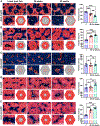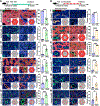Liver homeostasis is maintained by midlobular zone 2 hepatocytes
- PMID: 33632817
- PMCID: PMC8496420
- DOI: 10.1126/science.abb1625
Liver homeostasis is maintained by midlobular zone 2 hepatocytes
Erratum in
-
Erratum for the Research Article "Liver homeostasis is maintained by midlobular zone 2 hepatocytes," by Y. Wei, Y. G. Wang, Y. Jia, L. Li, J. Yoon, S. Zhang, Z. Wang, Y. Zhang, M. Zhu, T. Sharma, Y.-H. Lin, M.-H. Hsieh, J. H. Albrecht, P. T. Le, C. J. Rosen, T. Wang, H. Zhu.Science. 2021 Sep 3;373(6559):eabl8195. doi: 10.1126/science.abl8195. Epub 2021 Sep 1. Science. 2021. PMID: 34516857 No abstract available.
Abstract
The liver is organized into zones in which hepatocytes express different metabolic enzymes. The cells most responsible for liver repopulation and regeneration remain undefined, because fate mapping has only been performed on a few hepatocyte subsets. Here, 14 murine fate-mapping strains were used to systematically compare distinct subsets of hepatocytes. During homeostasis, cells from both periportal zone 1 and pericentral zone 3 contracted in number, whereas cells from midlobular zone 2 expanded in number. Cells within zone 2, which are sheltered from common injuries, also contributed to regeneration after pericentral and periportal injuries. Repopulation from zone 2 was driven by the insulin-like growth factor binding protein 2-mechanistic target of rapamycin-cyclin D1 (IGFBP2-mTOR-CCND1) axis. Therefore, different regions of the lobule exhibit differences in their contribution to hepatocyte turnover, and zone 2 is an important source of new hepatocytes during homeostasis and regeneration.
Copyright © 2021 The Authors, some rights reserved; exclusive licensee American Association for the Advancement of Science. No claim to original U.S. Government Works.
Figures






Comment in
-
In the zone for liver proliferation.Science. 2021 Feb 26;371(6532):887-888. doi: 10.1126/science.abg4864. Science. 2021. PMID: 33632834 No abstract available.
-
Novel insights into liver homeostasis and regeneration.Nat Rev Gastroenterol Hepatol. 2021 Jun;18(6):369-370. doi: 10.1038/s41575-021-00454-0. Nat Rev Gastroenterol Hepatol. 2021. PMID: 33911225 No abstract available.
-
Midlobular zone 2 hepatocytes: A gatekeeper of liver homeostasis.Cell Metab. 2021 May 4;33(5):855-856. doi: 10.1016/j.cmet.2021.04.005. Cell Metab. 2021. PMID: 33951471
References
Publication types
MeSH terms
Substances
Grants and funding
LinkOut - more resources
Full Text Sources
Other Literature Sources
Molecular Biology Databases
Research Materials
Miscellaneous

